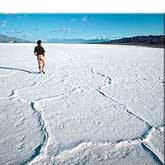Salty Remnants At Death Valley's Badwater
 Beneath the dark shadows of the Black Mountains, a great, extraordinarily flat expanse of shimmering white spreads out before you. You are at Badwater, at -282 feet it is the lowest spot in the Western Hemisphere. Step onto the trail and you'll see that the white expanse is made up of billions of crystals of almost pure table salt! As your feet crunch along the trail that leads onto the valley floor, you are walking on the salty remnants of a much greener, lusher time in Death Valley's relatively recent past. Not long ago, during the Holocene (about 2000-4000 years ago), the climate was quite a bit wetter than today. So wet that streams running from nearby mountains gradually filled Death Valley to a depth of almost 30 feet. Some of the minerals left behind by earlier Death Valley lakes dissolved in the shallow water, creating a briny solution.
Beneath the dark shadows of the Black Mountains, a great, extraordinarily flat expanse of shimmering white spreads out before you. You are at Badwater, at -282 feet it is the lowest spot in the Western Hemisphere. Step onto the trail and you'll see that the white expanse is made up of billions of crystals of almost pure table salt! As your feet crunch along the trail that leads onto the valley floor, you are walking on the salty remnants of a much greener, lusher time in Death Valley's relatively recent past. Not long ago, during the Holocene (about 2000-4000 years ago), the climate was quite a bit wetter than today. So wet that streams running from nearby mountains gradually filled Death Valley to a depth of almost 30 feet. Some of the minerals left behind by earlier Death Valley lakes dissolved in the shallow water, creating a briny solution.
The wet times didn't last. The climate warmed and rainfall declined. The lake began to dry up. Minerals dissolved in the lake became increasingly concentrated as water evaporated. Eventually, only a briny soup remained, forming salty pools on the lowest parts of Death Valley's floor. Salts (95% table salt - NaCl) began to crystallize, coating the surface with a thick crust about three to five feet thick.
Here at Badwater, significant rainstorms flood the valley bottom periodically, covering the salt pan with a thin sheet of standing water. Each newly-formed lake doesn't last long though, because the 1.9 inch average rainfall is overwhelmed by a 150-inch annual evaporation rate. This, the nation's greatest evaporation potential, means that even a 12-foot-deep, 30 miles long lake would dry up in a single year! While flooded, some of the salt is dissolved, then is redeposited as clean, sparkling crystals when the water evaporates.
Fact Credit
USGS General


